Bottle-Feeding Puppies
In the vast majority of cases, the mama dog will have an adequate milk supply and a burning desire to take care of her own puppies. However, if a litter is abandoned or the mother becomes unable or unwilling to take care of her puppies, you may find yourself in the position of having to bottle feed.
What equipment do I need?
Aside from a hungry puppy, you will need a towel to keep the puppy warm during feedings, several human baby bottles, a large yarn needle to enlarge the nipple hole, and the ingredients to make the formula (see below). Boil the bottles, caps, and nipples before using them for the first time, and between each use.
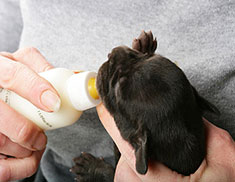
What do I put in the bottle?
Growing puppies have unique nutritional needs. First is the need for calorie-dense food so that they can take in sufficient energy (calories) without having to expend the energy to eat and excrete large amounts of fluid. If you buy the commercial puppy formula available from your veterinarian, you may find that it contains only one or two calories per cubic centimeter (cc) of fluid.
If you make your own, you can get the calories as high as eleven calories per cc. With this higher calorie density, you should be able to feed 1 cc of formula per ounce of puppy body weight every three hours. As the puppy gains weight, the amount of formula you are giving him or her will also increase. By about three weeks of age, you should be able to cut the number of feedings to four each day, and none overnight.
The breeders at Leerburg Kennel recommend whisking together the following ingredients:
- 10 oz. of goat's milk (may substitute 10 oz. of canned evaporated milk thinned with three ounces of boiled water)
- 1 raw egg yolk
- 1 Tablespoon mayonnaise
- 1 cup whole yogurt (not skim or fat free)
- ˝ teaspoon of karo syrup
Care should be taken not to over-blend the ingredients to the point where bubbles form, as they can cause the puppy to have very painful gas bubbles. This formula can be kept in the refrigerator for up to seven days.
The primary nutrition puppies need to grow is protein, which in the above recipe is provided by the milk, egg, and yogurt. They also need a good supply of fat to promote the development of the brain and nervous system. This is provided by the mayonnaise and the full-fat yogurt.
Do I use the boiled water to make heated formula?
After you have boiled the water, you should let it cool. Boiling water has a temperature of 212 °F, which is way too hot for the puppy. Once the water has cooled, you will make the formula, then heat it either on the stove or in the microwave.
After you have made your formula, you simply pour the desired amount into a baby bottle, and place the bottle in a pan of warm water on the stove until it reaches about 100 °F.
Microwaves can be used to heat bottles, but be sure to shake the bottle well after you heat it. Formula heats unevenly in the microwave, and you may have some of the milk too hot and some too cold if you don't shake the bottle thoroughly.
No matter which method you choose to heat the bottle, you can test the temperature by dripping a small amount of formula onto your arm. It should feel warm, but not hot.
How fast should the milk flow out of the bottle?
If you are using the recipe shown above or any other formula that is reasonably thick, you may have to use a sterilized yarn needle to enlarge the hole in the nipple. (Yarn needles have a large diameter and can be purchased at any craft store.) Heat the needle, then poke a few holes in the tip of the nipple.
When you hold the bottle upside down, the milk should drip out with just a gentle squeeze of the bottle, but it should not flow freely. If the milk comes out too quickly, the puppy may aspirate it into his or her lungs, causing pneumonia. Start enlarging the nipple hole bit by bit until you achieve the desired flow rate. Once you have made the hole too big you cannot mend it, so proceed carefully.
If the hole is too small, your puppy will have to strain to get the formula out. You want the puppy to be able to get enough formula to prevent dehydration without having to expend too much effort by trying to suck it through an insufficiently sized hole. If the puppy becomes exhausted or refuses to nurse, try making the nipple hole slightly larger.
Bottle feeding
Cradle the puppy in your arms and place the nipple of the bottle in his or her mouth. Make sure you are holding the puppy upright, not on his or her back. The puppy should begin sucking automatically, but if not, you can gently massage the chin and throat to encourage the suck reflex. Make sure the puppy is not putting the nipple under his tongue. It has to be on top of the tongue to work right.
Again, you should check the flow rate of the bottle. You may see a few bubbles coming out of the puppy's mouth, but you shouldn't see a continuous stream of formula. A continuous stream means you have made the nipple hole too big.
After bottle feeding
After you have fed your puppy, place the dog in a vertical position against your chest and pat him or her gently on the back until a burp is heard. Don't return the puppy to the whelping pen until he or she has produced a good burp. Leaving gas inside the dog will produce unnecessary pain.
If the puppy has not consumed all of the formula in the bottle, throw the excess away, as it is no longer sterile.
When do I start and stop bottle feeding?
To receive the mother's antibodies and start the puppy's immune system off right, the puppy should (ideally) receive mother's milk within the first twelve hours of life. If you can, make sure every puppy in the litter has a chance to suckle at his or her mother's breast during this important period. After twelve hours, the puppy cannot absorb the antibodies, so bottle feeding can be started if the mother cannot bring down enough milk or if one or more of the puppies is shunned.
When the puppies reach the age of about four weeks, you may begin putting formula in a dish rather than in a bottle. Once the puppies are used to lapping up their food rather than sucking it down, you can add some raw hamburger to the dish with the formula. At about six to eight weeks, you can begin to decrease the formula and progress to solid foods. If you are feeding a raw diet, you should start with soft foods and work your way up to solids. If you are feeding commercial kibble, start out by moistening the kibble with formula, then gradually work toward dry food.
Bowel problems in hand-raised puppies
Very young puppies must be encouraged to empty their bladders and move their bowels. Mama dogs do this by licking them, but you can use a moist cotton ball or washrag. Gently massage the puppy's anus and genital area until they figure it out. By about three weeks old, the puppy should no longer need this stimulation.
If the puppy has to strain to move his bowels, or if the stool is clumpy like cottage cheese, you will need to thin your formula by adding more boiled water or Pedialyte. Because you are diluting the formula, you will likely have to feed more often than every three hours.
If the constipation becomes severe, your puppy's tummy will begin to distend and bloat. Try giving the dog just a bit of petroleum jelly or mineral oil to help the stool pass. If that doesn't work, check with your vet about a warm water enema. You may be able to do this at home, or you may have to take the puppy to the clinic.
Normal puppy stools are very loose, approximately the consistency of jam. If your puppy has even looser stools, particularly if he or she moves the bowels more than once between feedings, the dog may have diarrhea. Give extra Pedialyte to make up for the lost fluids, and if the problem continues, see your vet. Puppies can become dehydrated very easily, and it can be fatal if not treated.
Other considerations when hand-raising a puppy
If the puppy becomes too hot, or if he or she won't nurse, dehydration becomes a concern. You may find the puppy has dry gums, or if you pinch the skin on the back of the dog's neck, it might stay tented rather than sliding back into place. If you see these signs, you must get more fluids into your puppy. You can either feed more formula or you can give Pedialyte.
Puppies have a hard time regulating their body temperature and may become easily chilled. Normally, they would snuggle with their mother and their litter mates, but if you are hand-raising a puppy, you will likely need to place a heating pad in the whelping box, covered with a towel or place a heating lamp above the box. Make sure there is a "warm area" and a "cool area" so you puppy can move between the areas as he or she needs to.
Low blood sugar can be a concern, particularly if the puppy is not nursing well. The puppy will become limp like a rag doll and may feel cool to the touch. As an emergency measure, you can give the puppy a drop or two of Karo syrup, but you will need to get the puppy to veterinarian if he or she doesn't respond within about five minutes to the Karo. Intravenous dextrose may be needed.
Doggies Den: Latest Articles
 Homemade Thanksgiving Treats for Your Dog
Homemade Thanksgiving Treats for Your Dog
NUTRITION We all want to include our dogs in our holiday celebrations, but hopefully, you're aware that sharing table scraps with your dog isn't always the best idea.
 Keeping Your Dog Safe during the Summer Months
Keeping Your Dog Safe during the Summer Months
HEALTH Summer is coming on fast, so it’s time to plan how you will keep your dog safe and healthy through the lazy, carefree, warm days.
 Vaccination Time Again-Keeping Your Puppy Healthy
Vaccination Time Again-Keeping Your Puppy Healthy
DOG HEALTH So you have your new puppy picked out. There are quite a few shots, treatments and examinations that will keep the newest member of your family healthy.
 Canine Thanksgiving Feast
Canine Thanksgiving Feast
NUTRITION With the wide variety of food at Thanksgiving dinner, chances are you'll want to give your dog something special, too. If you're contemplating what to feed your dog for the holiday, here is a guide to a great Canine Thanksgiving Feast.
 Dog Walking Tips Every Owner Should Know
Dog Walking Tips Every Owner Should Know
DOG FUN Walking your dog is not only crucial to keeping him healthy and happy, it strengthens the bond between your canine friend and his caregiver. There are a lot of obstacles out there. Don’t forget these simple tips to keep your walk fun and safe in the outside world.
 The Benefits of Physiotherapy for your Dog
The Benefits of Physiotherapy for your Dog
HEALTH The same techniques that physiotherapists use to treat a variety of injuries and conditions in humans have been adapted to suit animals with great success. Family pets, show dogs, and working dogs can all benefit greatly from physiotherapy. Dogs whose activities involve a lot of agility are especially susceptible to the types of problems that physiotherapy can address.
 The Decision- Adding a Dog to Your Family
The Decision- Adding a Dog to Your Family
FIRST TIME OWNERSBringing a dog into your family is a decision where many people don’t realize it’s magnitude until after they have the dog. There are a number of things that you need to research before you decide to purchase a dog, and it starts right in your own home.
 Bringing Your Dog Into Your New Baby's Life
Bringing Your Dog Into Your New Baby's Life
HEALTH Many believe that a dog and a new baby cannot happily coexist, so therefore the dog has to go. This is not necessarily the case.  A new baby does not mean you have to abandon your dog.

Doggies Den:
Most Popular Articles

Dog Pregnancy Symptoms
HEALTHIf you suspect your dog might be pregnant, check out part one in this series on pregnant dogs, where we cover pregnant dog symptoms.
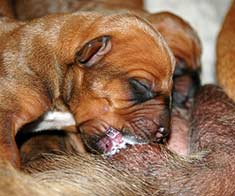
Dog Birth
HEALTHIn the third article of our dog pregnancy series, we look at the wonderful, but messy, process of bringing newborn puppies into the world.

Indoor Dog Potties
DOG PRODUCTSIt's been a long day at work. You were so busy, you didn't even take time to eat a sandwich, let alone run home to let your dog out. You're on your way home, knowing the poor dog is crossing his or her legs by now, when your car breaks down, delaying you even further. Can't somebody make this easier?
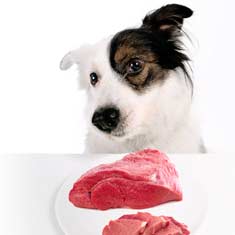
Your Dog’s Digestive System
PHYSIOLOGYEver wonder why your dog eats so fast? Or why he eats gross things? Or why he gets sick to his stomach? Or why his waste stinks so bad? Some of these things are normal, some are not.

Canine Respiratory System
BREATHINGThe basic function of your dog's respiratory system is to bring oxygen in to and remove carbon dioxide from the body. Knowing the symptoms of respiratory diseases can help you help your stay healthy.
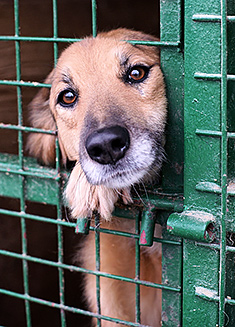
Shelter Dog Adoption Tips for Success
ADOPTION Are you intimidated by the prospect of "rescuing" a dog from a shelter? One reason that you may be wary of adopting a dog from a shelter is not knowing how to choose. Adopting a dog from a shelter can be a rewarding process, if you're prepared to do a reasonable amount of research.

Canine Urinary Tract Infections
SYMPTOMS AND TREATMENTDoes your dog seem to be having trouble relieving his or her bladder? Learn how to recognize the signs of urinary tract infections and how to treat them before they spread.

What to do for Dog Diarrhea
SYMPTOMS AND REMEDIESIf you have dogs in your house for any length of time, you have likely experienced at least one bout of dog diarrhea. Beyond the pain in the tuckus involved in cleaning up the mess, you should know what causes diarrhea, and when it's important to see the vet.
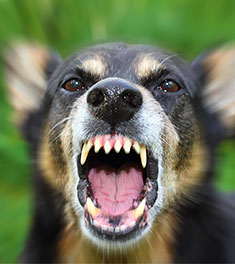
What to do for a Dog Bite
DOG BEHAVIOR Getting bitten by a dog can be scary, and you may be tempted to run around in circles for a while, trying to figure out what to do. Here's our guide to help you manage the situation.

Top Ten Tips for Living with a Senior Dog
DOG HEALTH Bringing home a new puppy is so exciting, but it doesn’t take all that long for your exuberant puppy to grow into a senior dog who may have special needs. Here are the doggies.com top ten tips for taking care of your companion who has been with you through so much.
